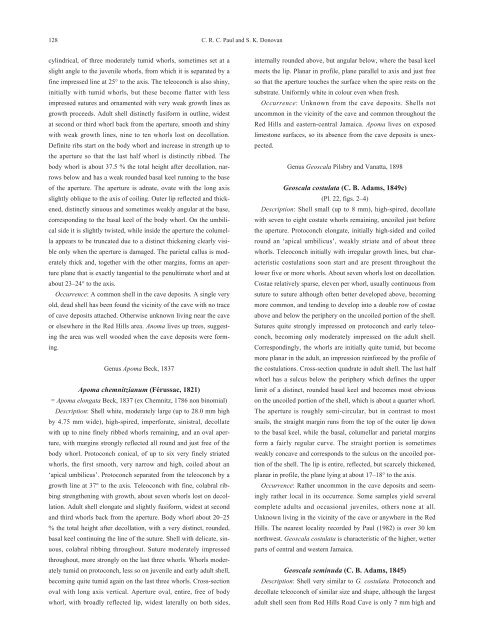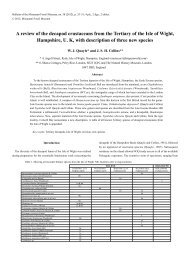Quaternary and Recent land snails (Mollusca: Gastropoda) from ...
Quaternary and Recent land snails (Mollusca: Gastropoda) from ...
Quaternary and Recent land snails (Mollusca: Gastropoda) from ...
You also want an ePaper? Increase the reach of your titles
YUMPU automatically turns print PDFs into web optimized ePapers that Google loves.
128<br />
cylindrical, of three moderately tumid whorls, sometimes set at a<br />
slight angle to the juvenile whorls, <strong>from</strong> which it is separated by a<br />
fine impressed line at 25° to the axis. The teleoconch is also shiny,<br />
initially with tumid whorls, but these become flatter with less<br />
impressed sutures <strong>and</strong> ornamented with very weak growth lines as<br />
growth proceeds. Adult shell distinctly fusiform in outline, widest<br />
at second or third whorl back <strong>from</strong> the aperture, smooth <strong>and</strong> shiny<br />
with weak growth lines, nine to ten whorls lost on decollation.<br />
Definite ribs start on the body whorl <strong>and</strong> increase in strength up to<br />
the aperture so that the last half whorl is distinctly ribbed. The<br />
body whorl is about 37.5 % the total height after decollation, narrows<br />
below <strong>and</strong> has a weak rounded basal keel running to the base<br />
of the aperture. The aperture is adnate, ovate with the long axis<br />
slightly oblique to the axis of coiling. Outer lip reflected <strong>and</strong> thickened,<br />
distinctly sinuous <strong>and</strong> sometimes weakly angular at the base,<br />
corresponding to the basal keel of the body whorl. On the umbilical<br />
side it is slightly twisted, while inside the aperture the columella<br />
appears to be truncated due to a distinct thickening clearly visible<br />
only when the aperture is damaged. The parietal callus is moderately<br />
thick <strong>and</strong>, together with the other margins, forms an aperture<br />
plane that is exactly tangential to the penultimate whorl <strong>and</strong> at<br />
about 23–24° to the axis.<br />
Occurrence: A common shell in the cave deposits. A single very<br />
old, dead shell has been found the vicinity of the cave with no trace<br />
of cave deposits attached. Otherwise unknown living near the cave<br />
or elsewhere in the Red Hills area. Anoma lives up trees, suggesting<br />
the area was well wooded when the cave deposits were forming.<br />
Genus Apoma Beck, 1837<br />
Apoma chemnitzianum (Férussac, 1821)<br />
= Apoma elongata Beck, 1837 (ex Chemnitz, 1786 non binomial)<br />
Description: Shell white, moderately large (up to 28.0 mm high<br />
by 4.75 mm wide), high-spired, imperforate, sinistral, decollate<br />
with up to nine finely ribbed whorls remaining, <strong>and</strong> an oval aperture,<br />
with margins strongly reflected all round <strong>and</strong> just free of the<br />
body whorl. Protoconch conical, of up to six very finely striated<br />
whorls, the first smooth, very narrow <strong>and</strong> high, coiled about an<br />
‘apical umbilicus’. Protoconch separated <strong>from</strong> the teleoconch by a<br />
growth line at 37° to the axis. Teleoconch with fine, colabral ribbing<br />
strengthening with growth, about seven whorls lost on decollation.<br />
Adult shell elongate <strong>and</strong> slightly fusiform, widest at second<br />
<strong>and</strong> third whorls back <strong>from</strong> the aperture. Body whorl about 20–25<br />
% the total height after decollation, with a very distinct, rounded,<br />
basal keel continuing the line of the suture. Shell with delicate, sinuous,<br />
colabral ribbing throughout. Suture moderately impressed<br />
throughout, more strongly on the last three whorls. Whorls moderately<br />
tumid on protoconch, less so on juvenile <strong>and</strong> early adult shell,<br />
becoming quite tumid again on the last three whorls. Cross-section<br />
oval with long axis vertical. Aperture oval, entire, free of body<br />
whorl, with broadly reflected lip, widest laterally on both sides,<br />
C. R. C. Paul <strong>and</strong> S. K. Donovan<br />
internally rounded above, but angular below, where the basal keel<br />
meets the lip. Planar in profile, plane parallel to axis <strong>and</strong> just free<br />
so that the aperture touches the surface when the spire rests on the<br />
substrate. Uniformly white in colour even when fresh.<br />
Occurrence: Unknown <strong>from</strong> the cave deposits. Shells not<br />
uncommon in the vicinity of the cave <strong>and</strong> common throughout the<br />
Red Hills <strong>and</strong> eastern-central Jamaica. Apoma lives on exposed<br />
limestone surfaces, so its absence <strong>from</strong> the cave deposits is unexpected.<br />
Genus Geoscala Pilsbry <strong>and</strong> Vanatta, 1898<br />
Geoscala costulata (C. B. Adams, 1849c)<br />
(Pl. 22, figs. 2–4)<br />
Description: Shell small (up to 8 mm), high-spired, decollate<br />
with seven to eight costate whorls remaining, uncoiled just before<br />
the aperture. Protoconch elongate, initially high-sided <strong>and</strong> coiled<br />
round an ‘apical umbilicus’, weakly striate <strong>and</strong> of about three<br />
whorls. Teleoconch initially with irregular growth lines, but characteristic<br />
costulations soon start <strong>and</strong> are present throughout the<br />
lower five or more whorls. About seven whorls lost on decollation.<br />
Costae relatively sparse, eleven per whorl, usually continuous <strong>from</strong><br />
suture to suture although often better developed above, becoming<br />
more common, <strong>and</strong> tending to develop into a double row of costae<br />
above <strong>and</strong> below the periphery on the uncoiled portion of the shell.<br />
Sutures quite strongly impressed on protoconch <strong>and</strong> early teleoconch,<br />
becoming only moderately impressed on the adult shell.<br />
Correspondingly, the whorls are initially quite tumid, but become<br />
more planar in the adult, an impression reinforced by the profile of<br />
the costulations. Cross-section quadrate in adult shell. The last half<br />
whorl has a sulcus below the periphery which defines the upper<br />
limit of a distinct, rounded basal keel <strong>and</strong> becomes most obvious<br />
on the uncoiled portion of the shell, which is about a quarter whorl.<br />
The aperture is roughly semi-circular, but in contrast to most<br />
<strong>snails</strong>, the straight margin runs <strong>from</strong> the top of the outer lip down<br />
to the basal keel, while the basal, columellar <strong>and</strong> parietal margins<br />
form a fairly regular curve. The straight portion is sometimes<br />
weakly concave <strong>and</strong> corresponds to the sulcus on the uncoiled portion<br />
of the shell. The lip is entire, reflected, but scarcely thickened,<br />
planar in profile, the plane lying at about 17–18° to the axis.<br />
Occurrence: Rather uncommon in the cave deposits <strong>and</strong> seemingly<br />
rather local in its occurrence. Some samples yield several<br />
complete adults <strong>and</strong> occasional juveniles, others none at all.<br />
Unknown living in the vicinity of the cave or anywhere in the Red<br />
Hills. The nearest locality recorded by Paul (1982) is over 30 km<br />
northwest. Geoscala costulata is characteristic of the higher, wetter<br />
parts of central <strong>and</strong> western Jamaica.<br />
Geoscala seminuda (C. B. Adams, 1845)<br />
Description: Shell very similar to G. costulata. Protoconch <strong>and</strong><br />
decollate teleoconch of similar size <strong>and</strong> shape, although the largest<br />
adult shell seen <strong>from</strong> Red Hills Road Cave is only 7 mm high <strong>and</strong>





